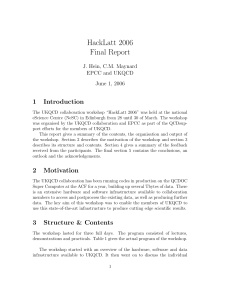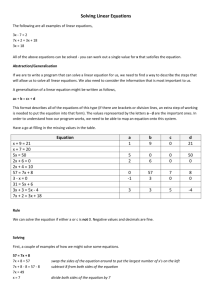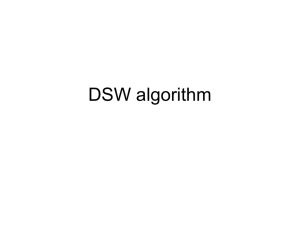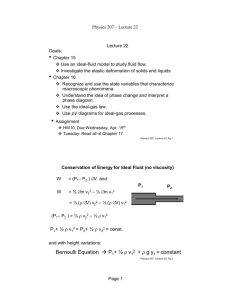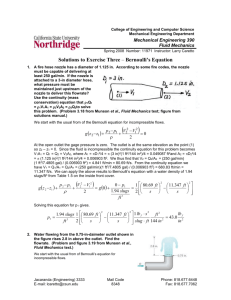multi1d u(Nd)
advertisement
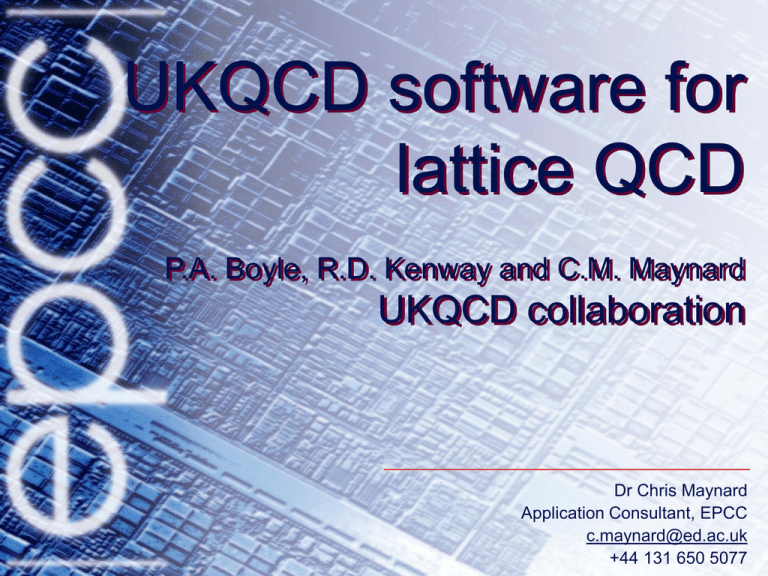
UKQCD software for
lattice QCD
P.A. Boyle, R.D. Kenway and C.M. Maynard
UKQCD collaboration
Dr Chris Maynard
Application Consultant, EPCC
c.maynard@ed.ac.uk
+44 131 650 5077
Contents
• Motivation
• Brief introduction to QCD
– What is the science
– What we actually calculate
– BYOC
• UKQCD software
– Why use more than one code base
– UKQCD contributions to code bases
• Conclusions
AHM2008
What is stuff?
Experiments similar to the
Large Hadron Collider (LHC)
probe the structure of matter
LHC will switch on 10 September 2008
AHM2008
Need a theory
to interpret and
understand
phenomena
and predict new
ones!
The Structure of matter
• Quarks have
–Mass feel gravity
–Charge feel
electromagnetism
–Flavour feel weak
interaction
–Colour feel strong
interaction
•Strong interaction binds
quarks into hadrons
–Protons and neutron
–Glued together by gluons
AHM2008
What are Gluons?
Gluons carry or mediate the strong
interaction
Quarks feel each other’s presence
by exchanging momentum via
gluons (virtual spring?)
Similar to photon in electromagnetism
Unlike photon carry charge of strong
interaction (colour) – couple to themselves
Gluons are sticky!
AHM2008
Introducing QCD!
• 1972 DJ. Gross, F. Wilzcek HD Politzer
– construct a Quantum field theory of quarks and gluon
based on a symmetry group for colour – Quantum
Chromodynamics (QCD)
– (prove QCD is asymptotically free)
– QFT for strong interaction
• 2004 Receive Noble prize
– Are we done?
… um, not quite
AHM2008
Asymptotic freedom
• Short distance/high momentum
strength of interaction is small
Converse is infrared slavery
•
• Low momentum strong
coupling
–Quarks are confined in hadrons
–Proton mass is ~1 GeV
A Feynman diagram
• Analytic tool (perturbation
theory) only works for small
interactions
AHM2008
Quarks and gluons on a lattice
• Replace 4d space-time with grid
– Lattice spacing a
• Quark fields on sites y(x)
– 4 component spinor (complex vector) on each site
• Gluon fields on links Um(x)
– 3x3 complex matrix on each link
• Equations of motion are partial differential equations
– Replace with finite difference
– Large ( Volume ), sparse matrix (Fermion matrix)
– Contains quark-gluon coupling
AHM2008
Numerical computation
• Infinite dimensional path integral
high dimensional sum
–
–
–
–
Hybrid Monte Carlo (HMC) and variants
Update quark and gluon fields
Invert the fermion matrix each update
Krylov subspace methods – conjugate
gradient
• Generate many paths – many gluon field
•
configurations
Compute (or measure) quantities of interest on
each configuration
– Invert the fermion matrix
• Average over all configurations
AHM2008
Why lattice QCD is hard
max
1
• Fermion matrix is badly conditioned
CN
• up and down quarks are nearly massless
min mq
• Statistical uncertainty
– Require at least O(105) MC
updates
– N~O(102) 1-5% stat error for
basic quantities
• Systematic uncertainty
– Several quark masses (chiral limit)
– Bigger box required for lighter masses
– 2 or more volumes (105-7) and
lattice spacings
• Scales badly with problem size
– a6 or a7 and at least 1/mq
AHM2008
The bottom line
• Need to invert matrices which are
• Very Large ~ O(107),
• Really badly conditioned
– CN O(104) or more
• Many, many times
–~O(106)
AHM2008
Quarks and gluons on a computer
• Interaction is local
– Nearest neighbour interactions
Parallel decomposition
Sub-volume of lattice on each processor
Simple communication pattern (halo-swap)
Regular communication pattern
AHM2008
Anatomy of a calculation
• Gluon and quark fields distributed
– Not Fermion matrix
– Exploit local interactions (sparsity) when evaluating matrix-vector operations
– Matrix-vector is M(x,y;U)•y(x)
– Colour matrix U(x) is small and dense, not split across PE
• Dominated by matrix-vector and global sums in iterative solver
– Double-precision floating point
• Computation versus communication
– Smaller local volume
– Greater proportion of data “near” processor
– More communication
• Machine limiting factors
– Memory bandwidth
– Comms latency and bandwidth
• QCD is ideally suited to MPP machine
– Build yer own?
AHM2008
QCD-on-a-chip (14K ASIC)
• ASIC from IBM technology library
• PowerPC 440 embedded CPU core
• 64-bit FPU - One FMA per cycle
• 4MB fast embedded DRAM
On chip memory
and Ethernet
controller
•Custom design
•High speed serial
links (DMA)
•Prefetching
EDRAM controller
• Bootable Ethernet JTAG interface
•400 MHz peak is 0.8Gflop/s
•Network is 6d torus of nearest
neighbour
AHM2008
QCDOC performance
Saturate single link
bandwidth for even small
packet size
Low latency
Good for small local
volume
Global vol 164
22x42 local volume 1K PE
Super-linear scaling as
data goes “on-chip
Linear thereafter
AHM2008
UKQCD collaboration
• 8 UK universities
–Plymouth joined in 2007
• Prior to QCDOC era (up to 2002)
–Consensus on form of calculation
–Collaboration owned FORTRAN
code
–Assembler kernel for performance
on Cray T3D/T3E
• QCDOC era
–Several (3) different calculations
–Each sub-group collaborates
internationally
–Two open source c++ codes
–CPS and chroma
–Assembler kernels for performance
AHM2008
SciDAC
• US DoE program
– Funds all US groups
– Hardware and software
– USQCD
• Code development
– Common code
environment
• UKQCD actively collaborates with USQCD
– Sub-project by sub-project
• USQCD and UKQCD orgs are funding based
– Lateral collaboration based on science!
– Collaborate on software module development
AHM2008
CPS before QCDOC
• Developed by Columbia University (CU) for QCDSP machine
–
–
–
–
–
Ancestor of QCDOC
Originally not ANSI c++ code
many QCDSP specific features
Not readily portable
Belongs to CU developers
• UKQCD chose this code base
– Building your own machine is a big risk
– CPS code base most likely to run on QCDOC from day 1
– Does have required functionality
• EPCC project to ANSI-fy the code
– Code now ran correctly (if slowly) everywhere else
AHM2008
UKQCD contribution to CPS
• Assembler version of key kernel
– P.A. Boyle via BAGEL assembler generator (see later)
• UKQCD develops new Rational Hybrid Monte Carlo (RHMC)
algorithm
– Implement and test in CPS (Clarke and Kennedy)
– New algorithm has many parameters
– Tuning and testing is a non-trivial task
• CU+BNL+RBRC (RBC) + UKQCD new physics project
– (2+1 flavour DWF)
– up and down degenerate + strange quarks
• UKQCD contribute to AsqTad 2+1 flavour project
– Other contributors in USA (MILC)
AHM2008
RHMC
• HMC alg evolves 2 degenerate flavours (M is
fermion matrix)
– Quark fields are anti-commuting Grassmann
variables
• Take square root to do one flavour
• Approximate square root to a Rational Function
• Roots and poles calculated with multi-shift
solver
• Terms with largest contribution to
the fermion force
– Change the MC update the most
– Cost the least to compute
• Change CG tolerance
– Loosen CG for terms which
contribute least
– Can reduce CG count 2x
• Keep algorithm exact with
Metropolis accept/reject
AHM2008
Implementing multi-timescale RHMC
• Can use RHMC nth-root to implement algorithmic tricks
• Multiple pseudofermions are better
• Mass preconditioning
• Multiple timescales
– Gluon, triple strange, light
– Allows a larger overall step-size with good acceptance
• Higher order integration schemes
• RHMC algorithm 5-10 times faster
– Binaries frozen since March 2006
AHM2008
CPS: good and bad
• CPS is written around target (QCDOC) hardware
• Code base runs (correctly) on target hdw
– Helps reduce risk when building own machine
– Includes much requisite functionality
• Adoption of CPS allowed UKQCD to focus on its strength
– Very successful algorithmic development
– Based on direct collaboration with RBC
• Still need to do measurements
– Invert fermion matrix (quark propagators) on gluon configurations
– Do measurements on different architectures
AHM2008
Chroma/qdp++
• Open source c++ code base
– Used by many different groups world-wide
• Multi-platform by design
• Highly modular, layered design
– QMP: Wrapper around message passing library e.g. MPI
– QDP++: Builds lattice valued physics data objects and manipulation
methods
– Hides message passing layer
– Allows “Under-the-hood” optimisations by expert developers
– Includes IO
– Chroma The physics library
– Rich physics functionality
• UKQCD has historical links with main developers
AHM2008
qdp++ :: plaquette example
Lattice valued data objects
Manipulation methods
multi1d<LatticeColorMatrix> u(Nd)
for(int mu=1; mu < Nd; ++mu){
for(int nu=0; nu < mu; ++nu){
LatticeColorMatrix tmp_0 =
shift(u[nu],FORWARD,mu) *
adj(shift(u[mu],FORWARD,nu));
LatticeColorMatrix tmp_1 = tmp_0 * adj(u[nu]);
Double tmp = sum(real(trace(u[mu]*tmp_1)));
w_plaq += tmp;
} }
AHM2008
qdp++ :: Abstraction
• Data objects are lattice valued
– No site index
– No explicit sum over index
• Linear algebra is encoded
– Code knows how to multiply 3x3 matrices together
• This has two consequences
• Expert HPC developer can modify implementation
– Optimisation, parallelism, architecture features
– Interface remains the same
• Application developer (Physicist) writes code which looks like
maths!
AHM2008
qdp :: Code like maths
multi1d<LatticeColorMatrix> u(Nd)
for(int mu=1; mu < Nd; ++mu){
for(int nu=0; nu < mu; ++nu){
LatticeColorMatrix tmp_0 =
shift(u[nu],FORWARD,mu) *
adj(shift(u[mu],FORWARD,nu));
LatticeColorMatrix tmp_1 = tmp_0 * adj(u[nu]);
Double tmp = sum(real(trace(u[mu]*tmp_1)));
w_plaq += tmp;
} }
AHM2008
qdp :: Code like maths
multi1d<LatticeColorMatrix> u(Nd)
for(int mu=1; mu < Nd; ++mu){
for(int nu=0; nu < mu; ++nu){
LatticeColorMatrix tmp_0 =
shift(u[nu],FORWARD,mu) *
adj(shift(u[mu],FORWARD,nu));
LatticeColorMatrix tmp_1 = tmp_0 * adj(u[nu]);
Double tmp = sum(real(trace(u[mu]*tmp_1)));
w_plaq += tmp;
} }
AHM2008
qdp :: Code like maths
multi1d<LatticeColorMatrix> u(Nd)
for(int mu=1; mu < Nd; ++mu){
for(int nu=0; nu < mu; ++nu){
LatticeColorMatrix tmp_0 =
shift(u[nu],FORWARD,mu) *
adj(shift(u[mu],FORWARD,nu));
LatticeColorMatrix tmp_1 = tmp_0 * adj(u[nu]);
Double tmp = sum(real(trace(u[mu]*tmp_1)));
w_plaq += tmp;
} }
AHM2008
Chroma: potential Downside
• At time of QCDOC development didn’t have RHMC
functionality
• Heavy use of c++ templates can defeat some compilers
– Stuck with Gnu compilers
– Code is very advanced c++. Not easy for beginners
• Main program driven by XML input files
– All objects created on the fly
– Requires a lot of functions to be registered
– QCDOC has small memory (especially .text)
• Chroma fails to compile on QCDOC
– Runs out of .text segment
– Physics library compiles OK
AHM2008
UKhadron
• Old-style main program
– Calls qdp++ and chroma library
– Harness the power of qdp++
– Focused on UKQCD physics requirements
– Most of measurement code for DWF project
– Iterative solvers
• Pros
– Runs on QCDOC and everywhere
– Control over code - small group of developers
– Can build integrated analysis code on top of qdp++
• Cons
– Compiling can be a headache!
– UKhadron requires specific versions of qdp++/choma
– Which require specific versions of Gnu compiles and libxml2
AHM2008
BAGEL
• Assembler generator written by Peter Boyle
– http://www.ph.ed.ac.uk/~paboyle/bagel/Bagel.html
• Composed in two parts
– library to which one can programme a generic RISC assembler kernel
– set of programmes that use the library to produce key QCD and linear
algebra operations
– generator is retargetable, key targets are ppc440, bgl, and
powerIII.
• Allows kernels to run at up to 50% of peak on target arch
AHM2008
Modular Build
• Both a blessing and a curse
–
–
–
–
Allows for modular, independent code development
Plug in performance code
Highly portable performance
Module version and compiler version dependence can be a problem
QMP Libxml2 Bagel lib
Bagel apps (bagel qdp, bagel wilson dslash)
qdp++
Can plug in other
kernels eg SSE
wilsonDslash
Chroma
UKhadron
AHM2008
Future
• Fastest machines are now BlueGene/P
– Multicore
• Cray XT4/BlackWidow
– Multicore/vector machine
• Multi-threading in qdp++: Mixed mode code
– Shared memory intra-node
– Message passing inter-node
• PGAS languages?
– UPC/CoArrayFORTRAN/Chapel/FORTRESS/X10?
• Hardware designed for QCD (BlueGene/Q)
– Performance kernel libraries
AHM2008
Physics
• CPS on QCDOC Gluon cfgs
• UKhadron on QCDOC
•
+BlueGene/L + HECToR
correlation functions
Implemented “twisted BC” in
UKhadron new calculation
LQCD data (TW BC)
Exp data
• World’s best calculation of
•
charge radius of pion
Can determine CKM matrix
elements
– Tests standard model at LHC
– P.A. Boyle et al JHEP07(2008)112
AHM2008
Conclusions
• QCD very complex problem
• Software is performance critical
– Very complicated
• UKQCD operates in a complex and changing
– Collaborative environment
– internally and externally
– Hardware regime
• Complex and evolving strategy
– Allows maximum flexiblity
– Gets the science done!
AHM2008
